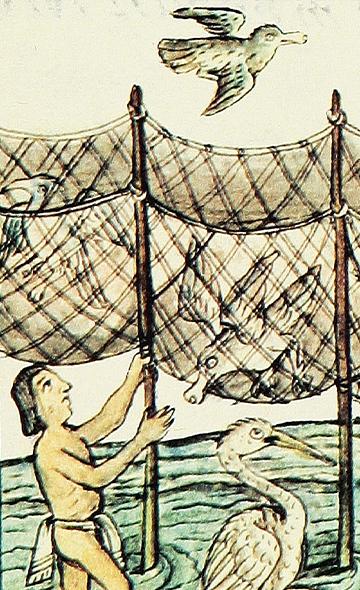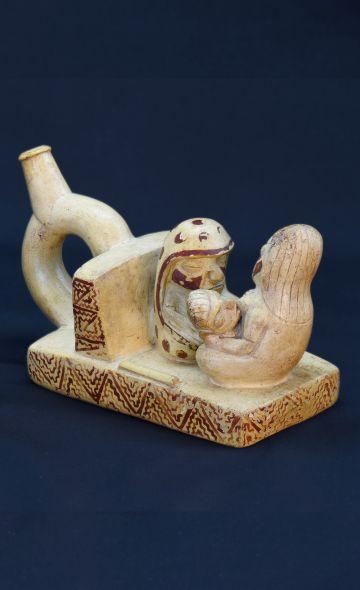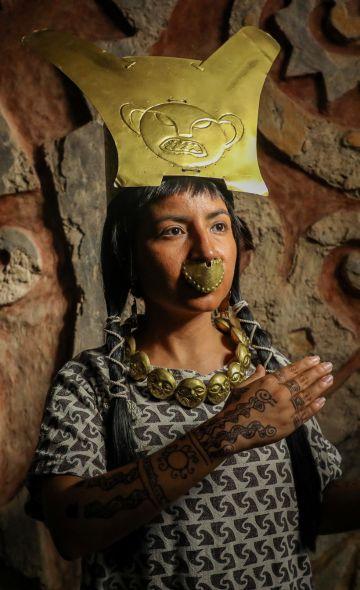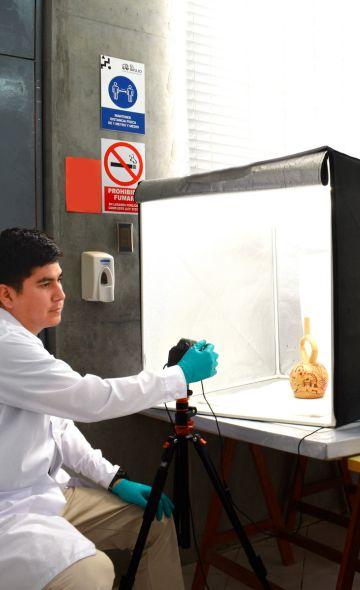- Visitors
- Researchers
- Students
- Community
- Information for the tourist
- Hours and fees
- How to get?
- Visitor Regulations
- Virtual tours
- Classic route
- Mystical route
- Specialized route
- Site museum
- Know the town
- Cultural Spaces
- Cao Museum
- Huaca Cao Viejo
- Huaca Prieta
- Huaca Cortada
- Ceremonial Well
- Walls
- Play at home
- Puzzle
- Trivia
- Memorize
- Crosswords
- Alphabet soup
- Crafts
- Pac-Man Moche
- Workshops and Inventory
- Micro-workshops
- Collections inventory
- News
- Researchers
- The breeding and hunting of animals in times of the Mochica culture
News
CategoriesSelect the category you want to see:
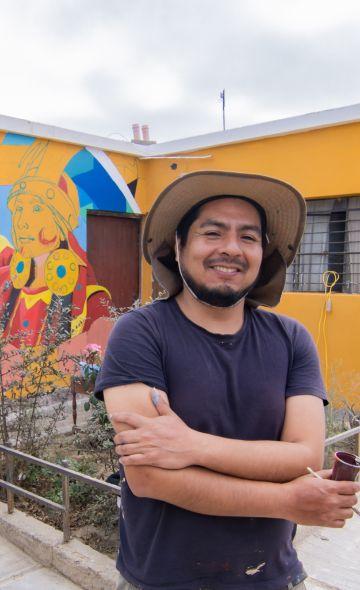
Magdalena de Cao to Once Again Host an International Mural Art Gathering ...
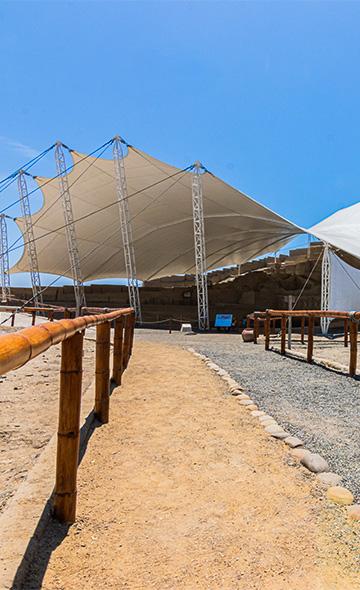
Explore El Brujo Through Virtual Tours: Culture and History at a Click ...
To receive new news.
By: José Ismael Alva Ch.
José Ismael Alva Ch.
Did you know that the Mochica carried out different animal hunting techniques? Also, that they had to raise animals for their food? Next, we will tell you more about these interesting activities that were carried out in ancient Peru.
Human beings have been consuming meat since time immemorial. In fact, researchers have proposed that this protein source promoted brain development in the evolution of our species (Arroyo, 2008). Because it was a food consumed by the vast majority, if not all populations, in ancient Peru animal husbandry, fishing and hunting were the main economic activities that guaranteed obtaining meat. Despite the above, the consumption of animal meat was not homogeneous, since it depended on factors such as: access to the ecological niches where the species lived, their availability in relation to natural cycles, the particular customs of the peoples, and social differentiations within human groups.
Meals in the Mochica epoch (100-800 AD) included the consumption of a certain number of animals from the coastal region. Although we know that coastal societies such as the Moche consumed a high diversity of fish, for which they developed different and sophisticated capture systems. In addition to fish meat, the Mochica had access to a variety of meats from mammals, birds and reptiles as we will see below.
What animals did they breed?
According to research carried out in the residential sectors of this society, such as those of Huaca de La Luna and the villages of the Moche valley, we know that the guinea pig, llama and alpaca were the animals that were mainly raised and that they were part of their usual diet (Gummerman and Briceño, 2003; Vásquez and Rosales, 2006; Vásquez et al, 2003).
Although the habitat of camelids is commonly associated with the high Andean areas, nonetheless, the evidence allows us to affirm that the rearing of llamas and alpacas occurred in a sustained manner in the lower and middle valleys of the coast. In this region, camelids were fed mainly with corn forage (Goepfert et al, 2014).
Regarding the breeding of guinea pigs, there is evidence that they were raised inside the houses, in the so-called "cuyeras" (guinea pig pens) and that they were fed mainly on forage until the moment when they were being consumed.
What animals did they hunt and how did they do it?
In addition to the animals they raised, the Mochica also hunted other species. The remains found in the residential area of Huaca de La Luna in the Moche Valley show that apart from domesticated species, the Mochica hunted other mammals, birds and reptiles for their diet.
The vizcacha
Although it usually lives in the Puna, this rodent can descend to 600 meters above sea level (León, 2013, p. 326). Father Bernabé Cobo indicated that the natives captured the vizcachas by means of snare traps, with which the prey was tied with a knot after being attracted by a decoy. Cobo also mentioned that, although the meat of the vizcacha “has good taste, it is very indigestible and heavy”, especially if it was eaten at night (1964 [1653], vol. I, p. 360).
The deer
The white-tailed deer prefers wooded areas, but can roam other ecosystems (León, 2013, p. 317). The Moche constantly depicted deer hunting scenes, in which well-dressed personages, great lords, according to Larco Hoyle (2001, p. 317), used nets to surround the animal and attack it with darts and maces. Probably, deer hunting was part of a ritual that coincided with the migration seasons of these animals.
The sea lion
According to Bernabé Cobo, sea lions were known, in the "language of the Incas", as azuca. The hunting technique for these animals was carried out on the islands of the coast, where they were hit with accurate blows with a stick on their nose (Cobo 1964 [1656], p. 295). Some representations of this form of hunting appear in the Moche ceramics, where the personages brandish maces and attack the group of sea lions.
The birds
Among the birds hunted by the Mochica, there is a variety of seabirds, aside from wild duck and pigeons. The capture mechanisms for birds were different according to the animal behavior patterns.
Father Bernabé Cobo, for example, documented that seabirds that lived on the islands such as the guanay (Guanay cormorant) were hunted at night, probably using nets, and from this bird they made stews (Cobo 1964 [1656], p. 317). The use of nets to capture birds is represented in the work General history of the things of New Spain (Mexico), written by the Spanish Franciscan monk Bernardino de Sahagún in the 16th century, where birds are shown being caught in flight. So, did the Moche use nets for hunting? Well, possibly yes, just as its use in deer hunting has been shown.
Other forms of bird hunting are pointed out by Larco Hoyle (2001, p. 323-325). It is about the use of blowguns, which consists in the use of a long rod to launch darts propelled by blows, and the huaripalo technique, a system whereby the birds were hit with a long rod.
The cañán
It is a reptile from the Peruvian coast that can reach up to one meter in length in adulthood. They live in the vicinity of the carob trees, since they consume their fruits (León, 2013, p. 340). Like the Iguana, the capture of the cannon can be done by hand after blocking their escape routes (Cobo 1964 [1656], p. 292; Larco Hoyle, 2001, p. 325).
What do we learn about Mochica food customs?
Thanks to archaeological studies we can know today what were the food customs of ancient civilizations such as the Moche, as well as the forms used to provide their livelihood. Due to this, today we know that the Mochica fed on a varied selection of meats from animals that they hunted, raised or fished, whose capture and rearing systems are the product of experiences and cultural traditions previously developed on the coast.
Although hunting is currently a regulated activity in order to guarantee the protection of native wild species, the raising of guinea pig, llama and alpaca, contributed to the Moche and other Andean peoples having constant access to important levels of protein, higher than those provided by chicken and beef today. Revaluing these native sources of protein from domesticated animals, unfortunately not very popular in today's coastal cities, would undoubtedly have a positive impact on the quality of our diet.
Bibliography
• Arroyo, P. (2008). Food in the evolution of man: its relationship with the risk of chronic-degenerative diseases. Medical bulletin of Hospital Infantil de México, 65 (6), 431-440.
• Bonavia, D. 1996. South American Camelids. An introduction to their study. Lima: Institut français d’études andines.
• Cobo, B. 1964 [1653]. History of the New World. First part. Library of Spanish Authors Volume XCI. Madrid: Atlas editions.
• Dufour, E., Goepfert, N., Gutiérrez, B., Chauchat, C., Franco, R., Vásquez, S. (2014). Pastoralism in Northern Peru during Pre-Hispanic Times: Insights from the Mochica Period (100-800 AD) Based on Stable Isotopic Analysis of Domestic Camelids. Plos One, 9 (1).
• Gummerman, G. and Briceño, J. (2003). Santa Rosa - Quirihuac and Ciudad de Dios: rural settlements in the middle part of the Moche valley. S. Uceda and E. Mujica (Eds.), Moche: towards the end of the millennium, Volume I (pp. 217-243). Lima: Pontificia Universidad Católica del Perú, Universidad del Perú.
• Kutscher, G. (1983). Nordperuanische Gefässmalereien des Moche-Stils. München: Beck-Verlag.
• Larco Hoyle, R. (2001). The Mochica. Volume II. Lima: Rafael Larco Herrera Archaeological Museum.
• León, E. (2013). 14,000 years of food in Peru. Lima: Fondo Editorial Universidad de San Martín de Porres.
• Sahagún, B. (1575-1577). General history of things of New Spain. Book XI: of natural things. https://www.wdl.org/es/item/10622/#q=codice+florentino
• Vásquez, V., Rosales, T., Morales, A., Roselló, E. (2003). Zooarcheology of the Moche urban area, Huacas del Sol y de la Luna complex, Moche valley. S. Uceda and E. Mujica (Eds.), Moche: towards the end of the millennium (Volume II, pp. 33-63). Lima: Pontificia Universidad Católica del Perú, Universidad Nacional de Trujillo.
• Vásquez, V. and Rosales, T. (2004). Archaeozoology and Archeobotany of Huaca de la Luna, 1998-1999. S. Uceda, E. Mujica and R. Morales (Eds.), Research in the Huaca de la Luna 1998-1999 (pp.337-366). Trujillo: Universidad Nacional de Trujillo.
• Vásquez, V. and Rosales, T. (2006). Analysis of Organic Remains (Zoological and Botanical) of CA-35 and CA-17, Moche Urban Zone - Huaca de la Luna. S. Uceda and R. Morales (Eds.), Huaca de la Luna Archaeological Project. Technical Report 2005 (pp. 275-302). Trujillo: Universidad Nacional de Trujillo.
Researchers , outstanding news


